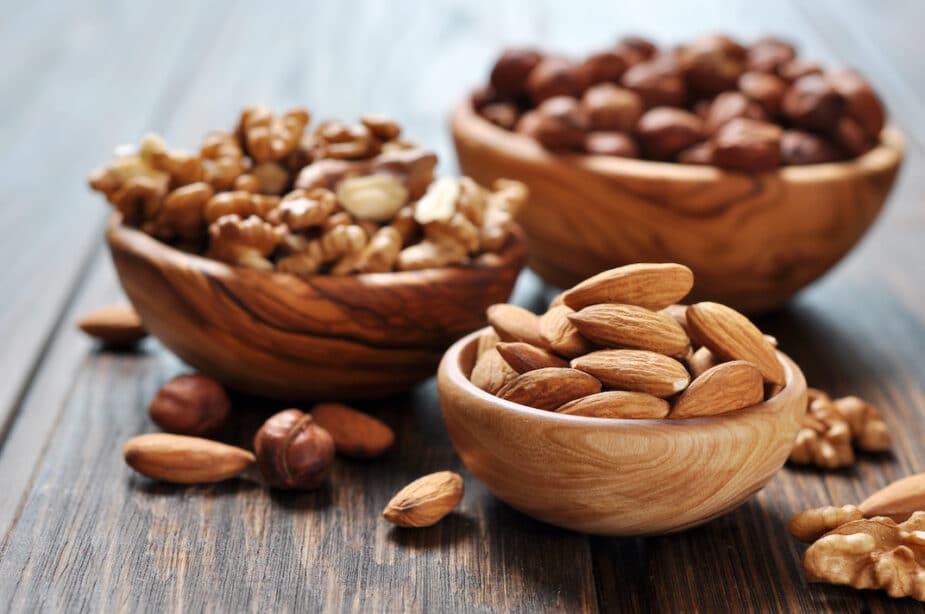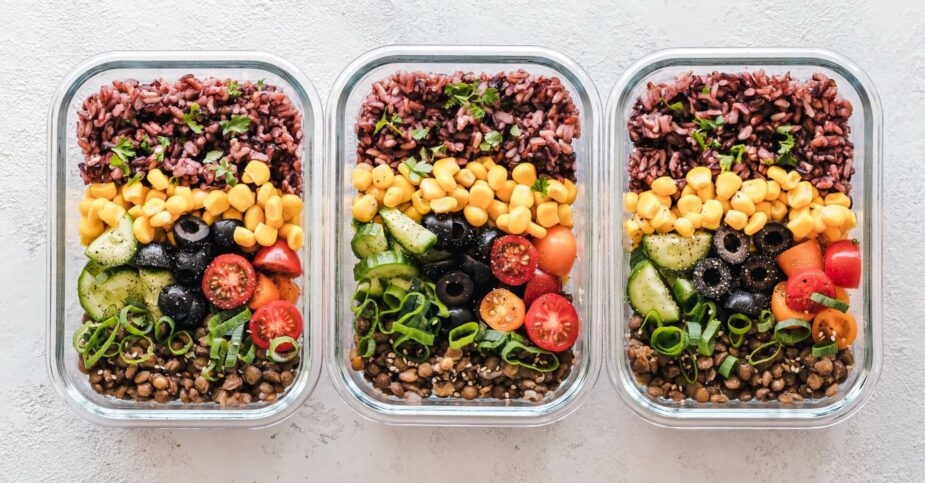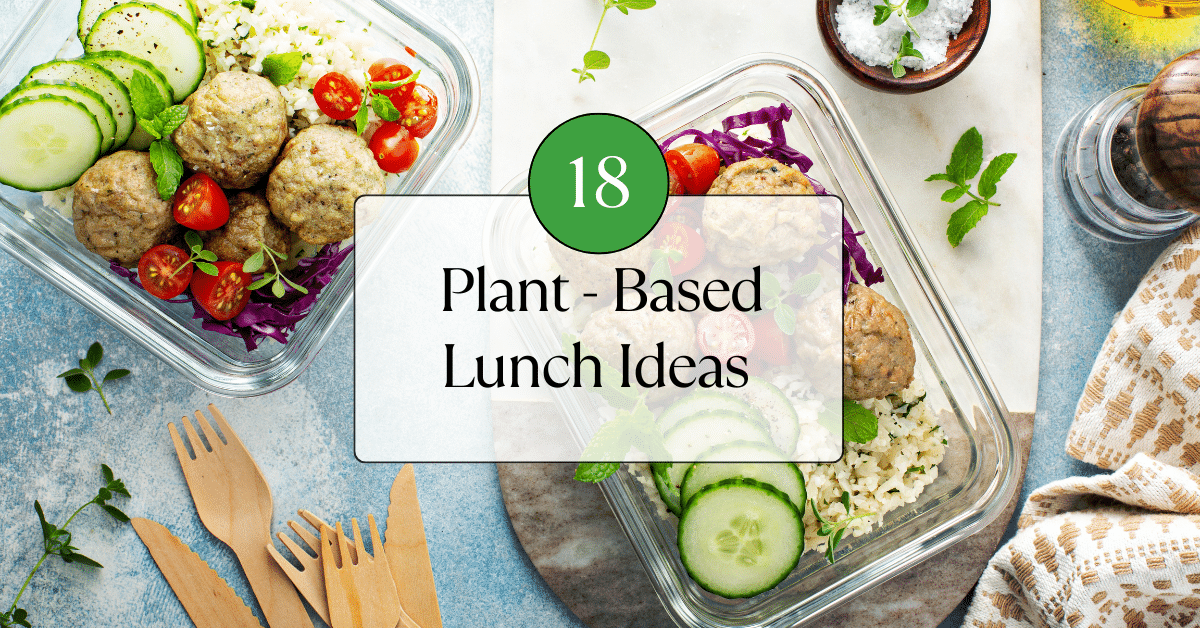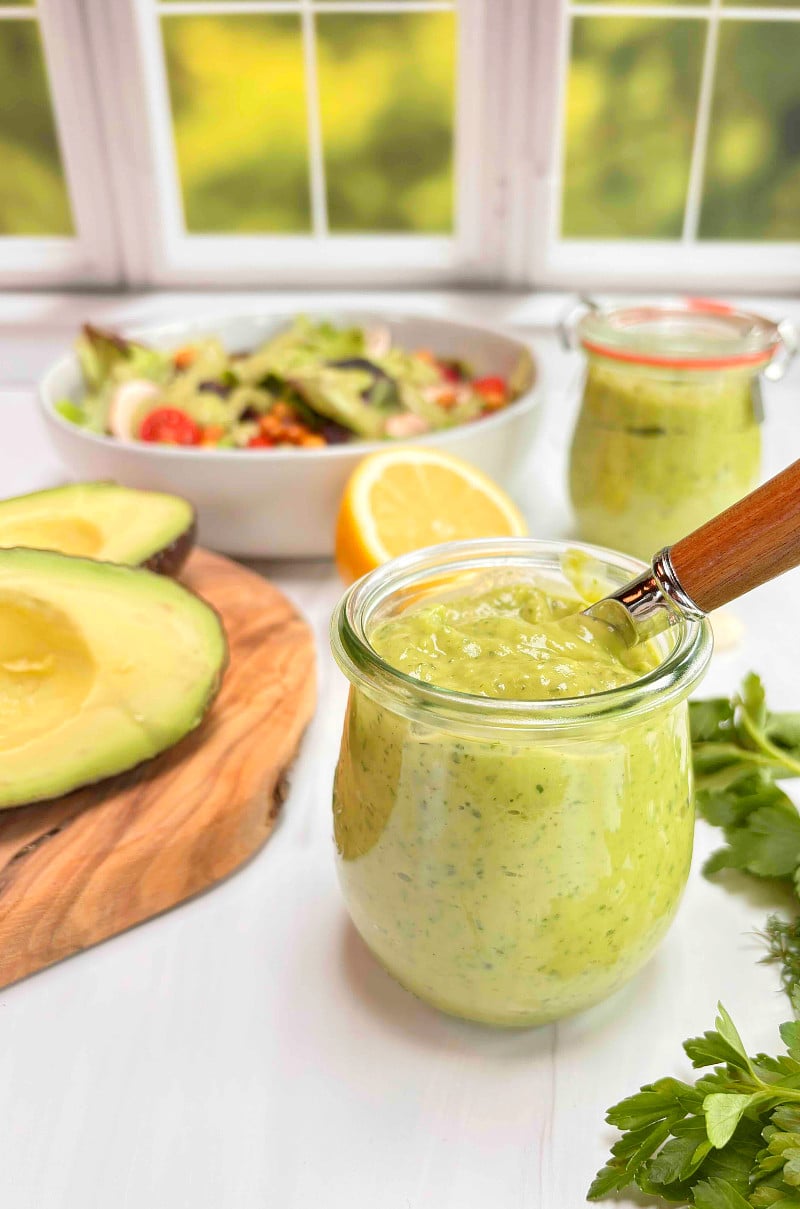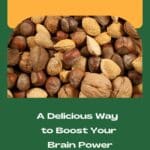Whether you’re craving an afternoon pick-me-up or seeking mental clarity in the morning, nuts are a perfect choice to give your brain a boost. These little powerhouses are not only delicious but also filled with essential brain-boosting nutrients.
You might be wondering, what makes nuts so special when it comes to brain health?
Hi! I’m Laura, a registered dietitian and culinary nutritionist. I also wrote the book, MIND Diet for Two (affiliate link) and am passionate about finding ways to keep our brains healthy, and eating healthy food, like nuts, is one key way.
Nuts are packed full of nutrients that protect our brains. In addition to protein, nuts contain brain-essential nutrients like antioxidants, vitamins, minerals, and healthy fats that may help preserve brain function and give your brain a boost.
These nutty little guys are incredibly versatile and can effortlessly be incorporated into any meal or snack. From breakfast to a late-night snack.
Let’s take a look at the top 5 nuts for brain health and explore some of my favorite ways to add them into your daily routine, ensuring you never miss out on their brain-boosting benefits.
Table of Contents
Why Are Nuts Good For Brain Health?
Nuts do more than just add a bit of crunch to a salad, oatmeal, or snack. They are packed full of nutrients that are good for your brain health. Let’s take a look at some of the health benefits of nuts.
Mood
One large study looked at people who ate a Mediterranean-style diet, supplemented with extra olive oil or extra nuts, and found those on the nut diet had a 20 to 30% reduced risk of developing depression over a 5 ½ year period.
Nuts, especially walnuts, almonds, and cashews contain tryptophan, an amino acid that releases the hormone serotonin which has a calming and mood-boosting effect. And you thought the turkey was the only tryptophan-rich protein that could help with sleep?!
Blood Pressure
It might surprise you to know that the same nutrients that keep your heart healthy are what seem to keep your brain healthy too.
Your brain is filled with an amazing network of blood vessels that help feed it and keep your brain cells alive. It needs a constant, unrestricted flow of blood to get the energy and oxygen it needs to function.
And you thought blood pressure only mattered for your heart health? Think again! Keeping your blood pressure under control is important for keeping blood flowing to your brain too.
Nuts are a treasure trove of minerals like potassium, magnesium, and calcium that work to keep your blood pressure under control and blood flowing.
People with high blood pressure are at an increased risk for strokes. A stroke will cut the blood flow to different parts of your brain and lead to long-term issues with mobility, speech, and even how well you think and process information.
So, does it matter if nuts are salted or not? Too much salt can contribute to high blood pressure so it is best to choose unsalted nuts as often as possible. Keep reading for an easy way to boost the flavor of nuts without adding salt!
Inflammation
We’ve been hearing more and more about the detrimental effects of inflammation on the body, and that includes inflammation in our brains.
Nuts are rich in magnesium, fiber, omega-3 fatty acids, and antioxidants, all of which have been shown to reduce inflammatory markers related to Alzheimer’s disease, cardiovascular disease, and insulin resistance.
A number of studies have looked at replacing saturated fats with foods high in unsaturated fats. Swapping in foods like nuts and reducing meat decreases inflammatory markers in the brain and reduces the risk of heart disease and stroke.
Plaque BuildUp
Nuts are high in insoluble fiber. This important nutrient helps reduce plaque build-up in our arteries and our brains.
Nuts are also rich in antioxidants including Vitamin E and some carotenoids including lutein. These nutrients help prevent the build-up of plaque on our artery walls, reducing LDL cholesterol levels and inflammation in our arteries as well as our brain, reducing the risk of stroke. They may also help reduce amyloid protein build-up in our brains, a characteristic of Alzheimer’s disease.
Nuts are also an integral part of the MIND diet, a healthy eating plan that has been shown to reduce or delay the development of dementia. Find out more about the MIND Diet here.
What are the Top 5 Nuts for Brain Health?
While all nuts have brain-healthy nutrients, these are my top 5 nuts for brain health. The ones I’ve included are packed full of important nutrients and they are easy to find and come with a reasonable price tag – I hear ya, it’s a challenge these days! 🙂
Almonds
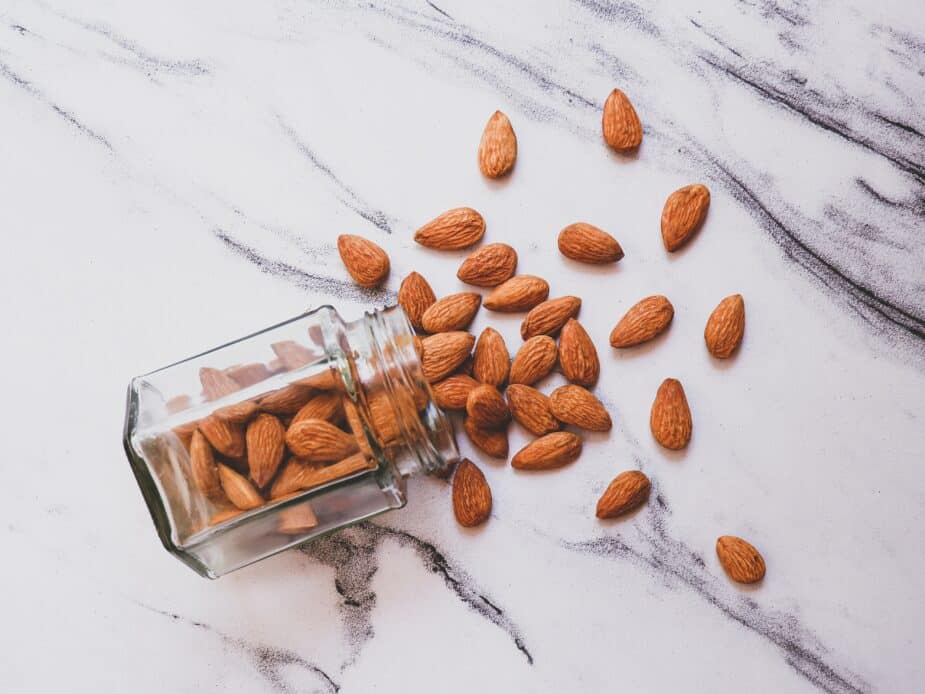
One of my favorite nuts is almonds. They are so easy to use in recipes because they have a mild nutty flavor and pair well with both sweet and savory foods. Toss them in a dish or oatmeal with fruit, or crush them and use them as a coating on fish, they add a mild, nutty flavor to your meals.
A recent study found middle-aged and older adults who ate 3 oz of almonds daily had improvements in memory and learning. While the research is early, almonds contain a lot of nutrients that may play a role in this.
Almonds contain something called a plant sterol. Plant sterols have a similar structure as cholesterol and because of that they compete with and seem to block cholesterol absorption. This helps lower total cholesterol and harmful LDL levels in our bloodstream and potentially limits plaque buildup in our brains.
They also have antioxidant and anti-inflammatory properties and may help reduce oxidative damage in our brains, potentially impacting our memory and ability to learn. A triple benefit!
Along with their sterol content, almonds are high in calcium, fiber, magnesium, and vitamin E, a powerful antioxidant.
One serving of almonds is 23 whole almonds or ¼ cup and contains:
Calories: 164
Fat: 14g
Protein: 6g
Carbohydrates: 6g
Fiber: 3.5g
Calcium: 6% DV
Magnesium: 18% DV
Potassium: 4% DV
Vitamin E: 50% DV
My favorite way to enjoy almonds: I love pairing almonds with chocolate and cherries. Check out my chocolate cherry biscotti for a delicious afternoon treat.
Walnuts
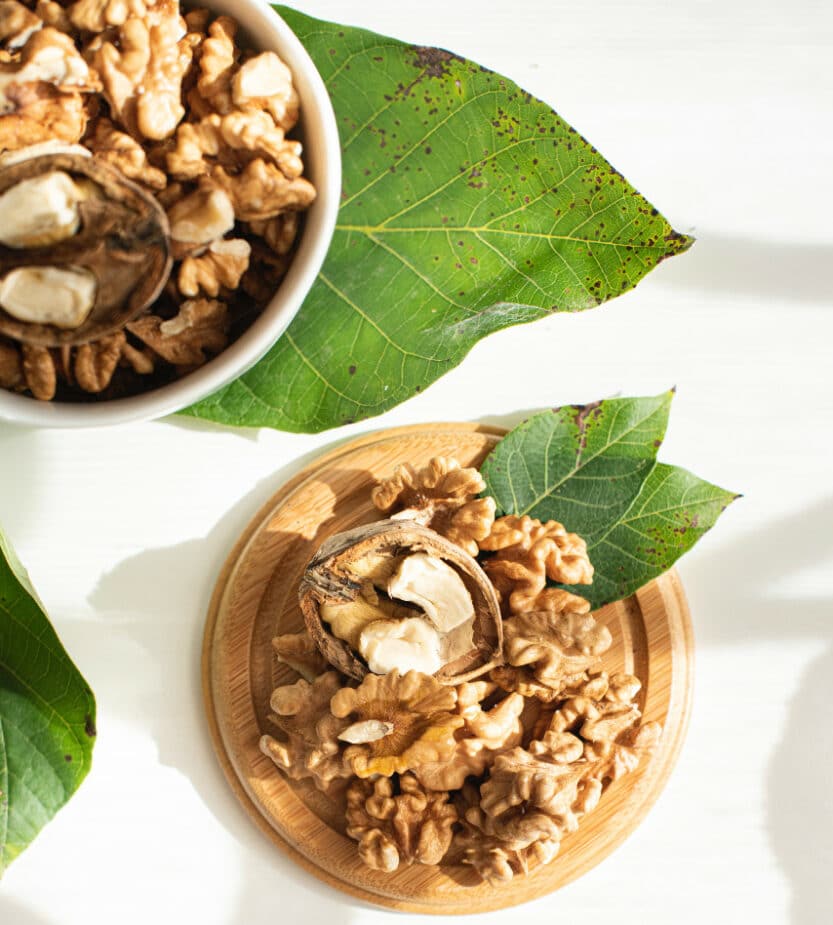
I always have a bag of walnuts in my freezer because I use them All. The. Time! You’ll find me tossing them in a salad, roasting them with vegetables, or mixing them into my morning oatmeal or yogurt. They add flavor and a delightful crunch and even a little butteriness to my meals.
Another reason I’m always adding them…they are a virtual treasure trove of antioxidants that are great for your brain. Flavonols, vitamin E, and selenium work together as a team, exhibiting an impressive anti-inflammatory effect. Keeping inflammation down keeps that oh-so-important communication system flowing!
Walnuts contain a plant-based omega-3 fatty acid called ALA which has been shown to help reduce the risk of heart disease and fight inflammation.
Both animal and human studies have shown adding walnuts to the diet helps improve brain function. Let’s take a closer look at the PREDIMED studies conducted in Spain. Their research found that incorporating just a little over 2 tablespoons of walnuts daily, alongside smaller amounts of hazelnuts and almonds, led to improved cognitive function and memory. It’s like giving your brain a delicious and nutritious treat!
Certainly, more research is needed, but adding a few of these little nuts to your diet means you’re taking a proactive step towards a healthier heart and a healthier brain.
A serving of walnuts is 1 ounce, or about ¼ cup, and provides:
Calories: 175
Fat: 17g (0.76g of the total fat comes from ALA omega-3)
Protein: 7g
Carbohydrates: 3g
Fiber: 2g
Calcium: 2% DV
Magnesium: 14% DV
Potassium: 3% DV
Vitamin E: 4% DV
My favorite way to enjoy walnuts: Walnuts go with so many different foods from salads, desserts, and savory foods but one of my favorite ways to use them is tossing them in with my roasted Brussels sprouts.
Pistachios
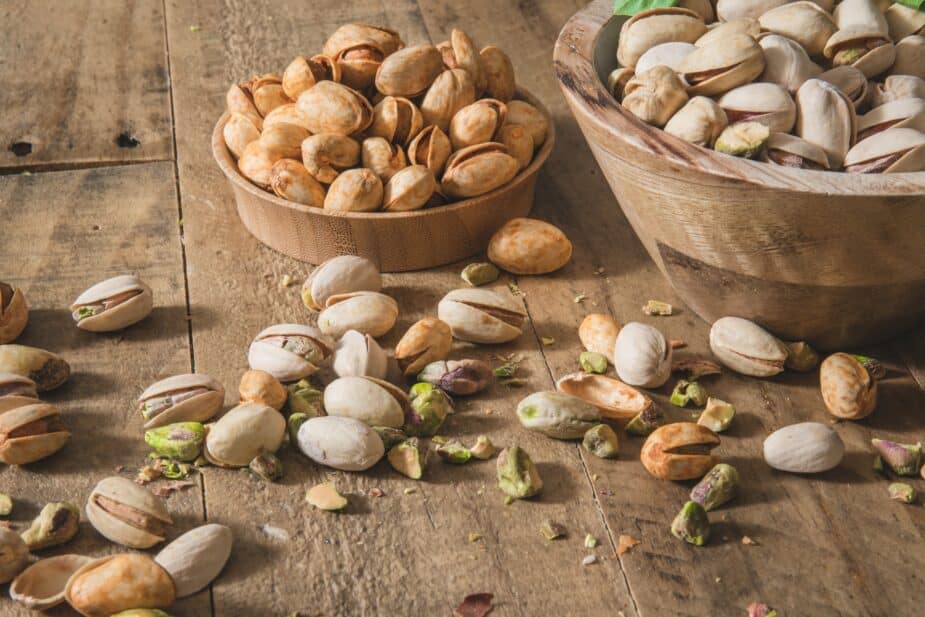
With their bright green color, pistachios are one of the only nuts that contain the carotenoids lutein and zeaxanthin. These compounds may also help improve blood flow to the brain, helping to keep your mind sharp and focused. They may help reduce the risk of eye diseases like macular degeneration, so an added bonus!
Interestingly, pistachios also contain melatonin – a hormone that helps regulate our sleep-wake cycle. And we know how important a good night’s sleep is for our brains to rest and recharge; these babies have more than any other fruit, vegetable, legume, or seed. Hmm…now there’s a good reason to enjoy a scoop of pistachio ice cream as an after-dinner treat!
One serving of pistachios is 1 ounce or about 49 nuts which provide:
Calories: 159
Fat: 12.8g
Protein: 6g
Carbohydrates:13g
Fiber: 3g
Calcium: 2% DV
Magnesium: 8% DV
Potassium: 6% DV
Vitamin E: 5% DV
Lutein and Zeaxanthin: 822mcg
My favorite way to enjoy pistachios: Their bright green color and rich flavor make these little nuts ideal for savory dishes. They add a burst of color to this delicious citrus, goat cheese, and farro salad. It’s packed with baby spinach too which is great for brain health also.
Pecans
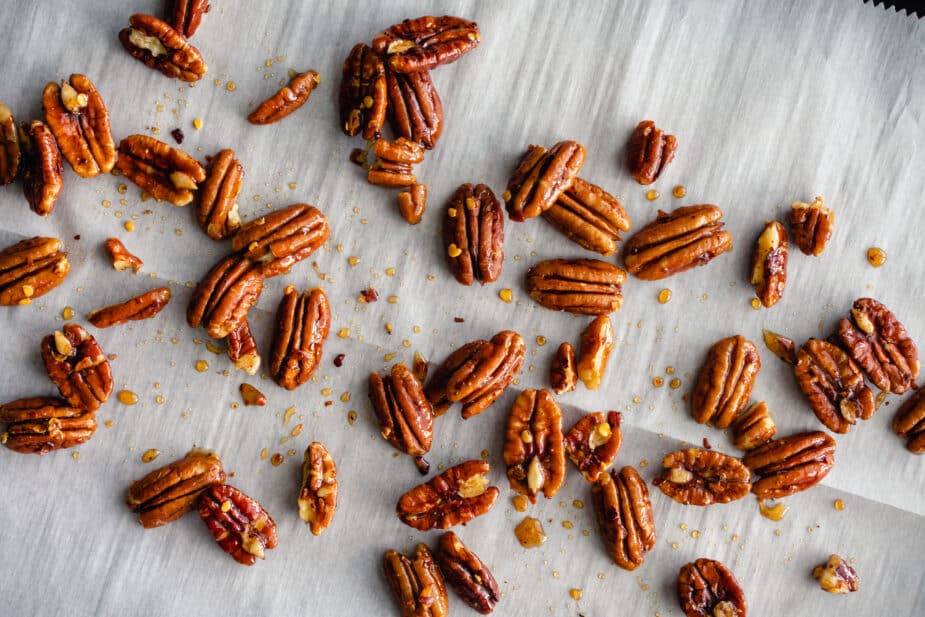
Because they are from the same family as walnuts, pecans have the second highest amount of unsaturated fats and ALA omega 3s of all nuts. They are primarily grown in the US, with Georgia being the top producer followed by Texas and Oklahoma. The word pecan is a Native American word that means it is a nut that “requires a stone to be cracked.”
Like the other nuts listed here, pecans are rich in antioxidants, monounsaturated fats, and flavonols. They are also food sources of zinc and copper, two nutrients important for brain growth and cognition.
Interestingly lower levels of zinc have been found in people with Alzheimer’s disease and young children with zinc deficiencies have decreased cognitive development and learning disabilities.
Some smaller studies have found an increase in antioxidant capacity and a decrease in LDL cholesterol after the consumption of pecans in healthy adults.
These delicious nuts have a distinct flavor that is light, slightly sweet and I think a bit buttery. They are always a nice compliment to sweets and pastries, but also add a delicious flavor to roasted fish, another brain-boosting food!
I will often crush them and use them as a coating on baked flounder or other white fish. (You can find a recipe for pecan-crusted trout in my cookbook, MIND Diet for Two – Note, this is an affiliate link.)
A 1oz serving of pecans or about 20 pecan halves contains:
Calories: 196
Fat: 20g (0.28g of the total fat comes from ALA omega-3 fatty acids and 11g from monounsaturated fats)
Protein: 2.5g
Carbohydrates: 4g
Fiber: 3g
Calcium: 2% DV
Magnesium: 8% DV
Potassium: 2% DV
Vitamin E: 4% DV
Zinc: 12% DV
Copper: 37% DV
My favorite way to enjoy pecans: Raise your hand if you agree that a gooey and rich pecan pie just has to be the ultimate in deliciousness, am I right? But we are focusing on brain health here and that pie is so decadent I know I can only treat myself once in a while! So for this purpose, we’ll go with my second favorite way, which other than using them as a coating on fish, I love to add them to a healthier version of baked goods like these delicate blueberry muffins. I added the pecans to the streusel-like topping so you get the full pecan flavor as soon as you bite in.
Hazelnuts
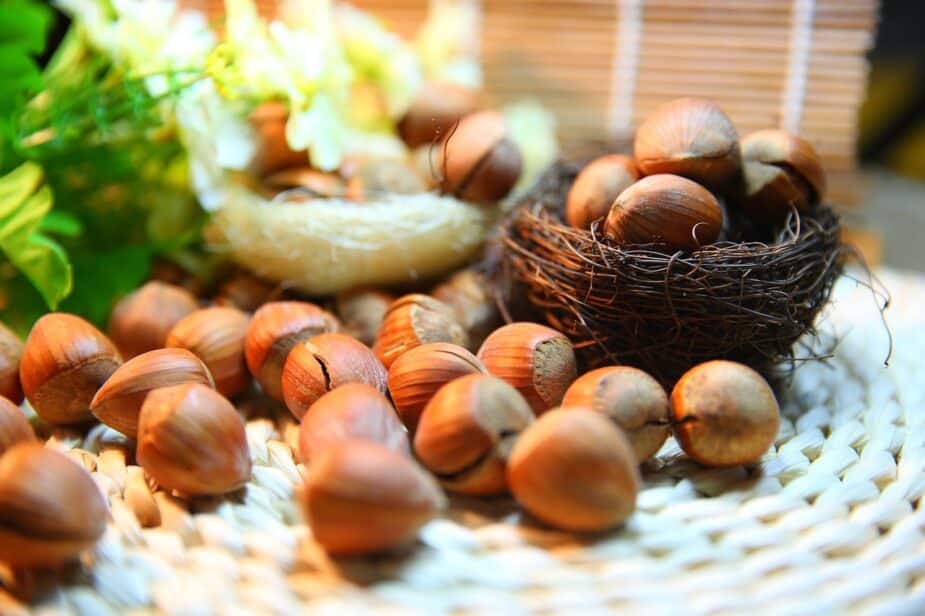
I saved the best for last!
While common in Mediterranean countries, hazelnuts (also called filberts) aren’t on most Americans’ list of commonly enjoyed nuts, but they should be! These round little guys are native to the Mediterranean and the majority are grown in Turkey. They are also grown in the US, primarily in Oregon.
Now, when you do think of hazelnuts you probably think of Nutella®, that deliciously decadent chocolate spread but there are so many other ways you can enjoy these.
A serving of hazelnuts is one ounce or about 20 nuts. One ounce of hazelnuts has about 4 grams of protein and 3 grams of fiber.
They are high in vitamin E, copper, and manganese, as well as the essential B vitamins, thiamine, and folate. The skin of the hazelnut is where the real goodness lies as it is the part of the nut that is the richest in antioxidants. Those antioxidants and vitamin E have been associated with reduced levels of inflammation, and like other nuts may have a role in protecting our memory.
A serving of hazelnuts is one ounce or about 20 nuts and contains:
Calories: 178
Fat: 17g
Protein: 4g
Carbohydrates: 5g
Fiber: 3g
Calcium: 2% DV
Magnesium: 11% DV
Potassium: 4% DV
Vitamin E: 28% DV
My favorite way to enjoy hazelnuts: I have to agree that Nutella was onto something when they created their amazing spread. Hazelnuts and dark chocolate are the ultimate combination of deliciousness. And, well, a little treat of dark chocolate (with its own antioxidant benefits) is a perfect addition to any meal. One of my favorite ways to enjoy them is in this dark chocolate hazelnut granola which adds a bit of richness to a bowl of yogurt and strawberries or as a topping on ice cream.
What About Peanuts?
So, technically, peanuts aren’t nuts! I know, crazy, right? But it’s true. Peanuts are actually a legume because of how they grow. Now, they certainly could be included on this list of nuts for brain health because they contain many of the same nutrients and benefits as the 5 nuts above but, I chose to leave them off this list for now and may devote an entire post to them later.
FAQs
As we’ve learned more about the health benefits of nuts there has been an explosion of nut-based food products on the market. Everything from various nut butter products to nut-based cooking oils and milk-like products. Do you get the same benefits out of these as the whole nut? And what is the best way to store and cook with nuts? Here are a few answers to some of those questions.
Nut butter that is just finely ground nuts and without a lot of additives has the same nutrient profile as the nut they come from. Some nut butter may have added oils like palm oil or fully hydrogenated oil. They are used to keep the butter smooth and creamy.
This does not mean they have trans fats. Fully hydrogenated fats do not contain trans fats. Partially hydrogenated fats were a big concern but no longer! As of 2020, the FDA does not allow partially hydrogenated oils (the kind high in trans fats) to be used in food products. One less thing to be concerned about!
Keep in mind the portion size as they are a concentrated form of calories and fat, but certainly, go ahead and enjoy a smear of almond butter on toast in the morning and reap the same benefits as you would get from a handful of almonds.
Both nut oils and olive oil are good for brain health. Nut oils contain both healthy polyunsaturated and monounsaturated fats and antioxidants found in whole nuts. Using them for cooking along with olive oil is a great way to get some extra nutrition and boost your brain health.
Nut oils have a stronger flavor than olive oil and they tend to have a lower smoke point, meaning the oils lose nutrients and become bitter when cooked at a high temperature. Nut oils are typically best for salad dressings or as a drizzle on finished food to add a burst of flavor and some extra nutrition.
Because of their high oil content, nuts oxidize quickly when stored at room temperature. The best way to store nuts is to wrap them tightly and either refrigerate or freeze them until you are ready to use them.
The flavor of nuts intensifies as they toast. While the oil in nuts oxidizes slightly when the nut is exposed to heat, the amount of nutrient loss tends to be small. Roasting brings the oil to the surface of the nut, which is what helps intensify its flavor. No need for salted nuts here! Toasting brings out all the flavor you need. I think it is always a good idea to toast nuts before you use them in cooking or baking.
There are 2 good ways to toast nuts – on the stovetop or in the oven. Both methods work well but they require you to pay close attention because once they start toasting, they cook quickly and it’s easy to end up with burned nuts. The stovetop method works best for a small amount of nuts while oven toasting is great when you have a lot to toast.
To toast them on the stovetop, place them in a non-stick skillet in a single layer and cook over medium-high heat until they start to brown, shaking the pan to keep them moving and turning. As soon as they start browning, remove them from the heat and put them in a separate dish to cool.
Oven toasting works well if you have a lot of nuts to toast. Preheat the oven to 350°F and place the nuts in a single layer on a sheet pan. Place them in the middle of the oven and cook for 6 – 10 minutes, until they begin to brown. You’ll probably be able to smell them!
Bottomline
Bursting with healthy fats, vitamins, and antioxidants, nuts are a nutritional powerhouse that can help support our brain. They keep blood flowing through our brains, reduce oxidation, and help promote sleep. The nutrients in nuts are a delicious way to give your brain a little boost.
So sprinkle them on your salad, generously pile them on your steaming bowl of oatmeal, or simply enjoy them as a satisfying snack! Any of these 5 brain-loving nuts is your ticket to a sharper, smarter, and healthier mind. Remember, variety is the spice of life, so grab a handful this afternoon and start reaping the benefits!

